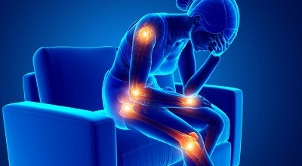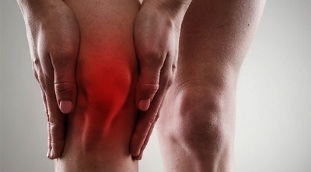The tissue of healthy joints consists of cells that can recover from damage - regeneration. Bones, cartilage, synovium, and other components can become unhealthy. Dead, damaged cells accumulate in certain tissues. They don't have the ability to divide, which hinders regeneration. They are difficult to remove, which is the main problem in restoring joint health.
With any physical exertion, strong mechanical stress can damage the cells and lead to their death. It is difficult for an already diseased joint to carry the load. It is very difficult to heal. To avoid or overcome disease, it is necessary to understand the defense mechanisms of joint tissues and cells. In the area of joint damage, a distinction is made between arthritis, arthrosis, polyarthritis and other diseases. Let's consider in detail the difference between arthritis and osteoarthritis.
First cause of illness
The joint is protected by neuromuscular damping. Thanks to the muscle contraction control system, the shock effect does not occur or is not diminished. The nervous system ensures smooth movements and load distribution. In a calm state, the muscles also stimulate microvibrations, which leads to the release of lubricant and the removal of dead cells.
Impaired neuromuscular damping occurs due to poor conduction of the nerve pathways. For example, fatigue weakens the defenses of a joint. Dead cells begin to accumulate without having time to excrete. The result is inflammation. The weakening of the protection accelerates the breakdown not only of the joints, but also of the spine.
A number of factors increase the risk of joint disease, starting with blows, bruises, overwork and hypothermia. Arthritis occurs - an inflammatory process. When it is impossible to cure for months, deformities begin - osteoarthritis.
What is arthritis: causes, symptoms
The reasons for the occurrence can be given:
- Wrong food.
- Bad habits: alcohol, smoking.
- Systematic hypothermia.
- injuries.
- Excessive stress on the joints.
- Consequences of previous illnesses, infections.

The disease is recognized by the following symptoms:
- Swelling in the joint area, painful sensations, increased sensitivity, restricted range of motion (i. e. synovitis).
- Severe pain when moving and resting.
- Stiffness in the morning due to swelling overnight. The activity passes one hour after the start.
In addition to the signs listed, symptoms of inflammation may occur: weakness, sweating, chills, fever. Some have a headache, weight loss. Sometimes comorbidities occur: the heart and lungs are affected.
What is osteoarthritis: causes and symptoms
As a result of progressive arthritis, the symptoms of osteoarthritis usually only appear after 40 years.
The disease is characterized by the following manifestations:
- The pain does not occur in a calm state, but rather during exertion. Unpleasant sensations occur in the hip or knee joint when walking, using a ladder, or exercising. This initial pain may go away with further movement. There is also a strong painful feeling, accompanied by a crunch when bending, bending.
- Pain at the beginning of movement after rest occurs as a result of the deposition of detritus on the friction surfaces - products of the destruction of cartilage and bones. The feeling may stop after 15 minutes because this sediment is being pushed out.
- Dull pain at night occurs as a result of venous congestion.
With osteoarthritis, inflammation often occurs. Swelling is observed along with painful sensations (as in arthritis). If symptoms of both diseases are present, osteoarthritis arthritis is diagnosed.
A long course of osteoarthritis can lead to restricted mobility. In the muscles, tendons begin, degenerative changes (contractures), and then deformations. In this case, the diagnosis is made - deforming osteoarthritis or osteoarthritis.
Distinguish the stages of the disease, which are determined by x-rays as a result of computed tomography:

- 1 degree- slight changes in cartilage, bones. Painful swellings occur with moderate exertion and decrease after a period of rest.
- 2 degrees- destruction of the cartilage, growth of bone tissue at the edges in the form of osteophytes. Narrowing of the joint space, accompanied by constant pain. Swellings also become stable.
- 3, 4 degrees- extensive destruction of cartilage and bones. The swelling does not go away, the ligaments and muscles do not work properly, and deformation occurs. The load axis is disturbed in the joint.
Risk factors for osteoarthritis are:
- Lack of mobility.
- overweight.
- Age factors.
- Infections due to insufficient blood and lymph flow, stagnation.
In all situations, the tissues do not have time to recover during the process of joint destruction.
Differences between arthritis and osteoarthritis
Both arthritis and osteoarthritis are becoming more common. Joint diseases have similar names. The differences lie in the type of negative changes that occur during the onset and development of symptoms. Arthritis pain is a result of tissue inflammation. The synovia is affected, the blood supply is disturbed, the lymph is disturbed, the disease affects the nerve endings. The joint no longer eats properly and it no longer produces lubricant. Cartilage suffers.
The disease can be observed not only in adults, but also in children (juvenile form). The lesion affects all joints, including small ones such as fingers, and can cover several of them (polyarthritis).
Osteoarthritis occurs as a result of persistent arthritis. The cartilage and the entire joint are not nourished by the synovial fluid (lubricant) for a long time. Often there are exacerbations in the form of inflammation. First, the cartilage is destroyed like the covering of the bone, and in the following stages the bone tissue can suffer. The cartilage areas do not have time to regenerate, they soften. Pain occurs due to the injury to the sliding surfaces in the joint.
This disease occurs after 40 years. In the case of large joints (hip coxarthrosis or knee gonarthrosis), this can create a disability and hinder a person. Fingers (osteoarthritis) and feet are less often affected. And the disease can also be observed in the temporomandibular joint, elbow, shoulder and other joints.
Thus, osteoarthritis is a consequence of the development of symptoms of arthritis, which adopts a destructive stage.
Prevention and treatment

Cartilage and joint deficiencies in arthritis should not be made worse by inflammation. Simultaneously with the repayment of the flock with anti-inflammatory drugs, it is necessary to get rid of the cause. If you don't do anything, the disease can turn into osteoarthritis. If you suspect both complaints, then you need to make a correct diagnosis, for which you need to consult a specialist doctor. This is done by a rheumatologist, orthopedic traumatologist, and surgeon. It is necessary to visit the clinic. In some diagnostic centers, such patients are looked after by an arthrologist.
An important principle of healing is to stop the destruction while stimulating recovery. This approach helps prevent irreversible changes. For this purpose, the tissues are cleaned of damaged cells caused by injuries or infections. Increase blood and lymph flow, nutrition. Inadequate conduction of the nerve connections from the spine is often the cause of the development of arthritis and osteoarthritis. When signs of disease appear, it is necessary to reduce the load on the joint.
Drug therapy includes:
- Nonsteroidal drugs that inhibit inflammation and relieve pain.
- Hormonal preparations in the form of injections.
- Cytostatics reduce the number of antibodies that kill cells.
- Cartilage and synovial fluid are restored with chondoprotectors.
The lymph flow that cleans the tissue of the affected cells is not stimulated. However, there is one method of vibroacoustic therapy which is to subject microvibrations from vibroacoustic therapy (from 30 to 20, 000 Hz). And physiotherapy, exercises are also used. In 3 and 4 stages of the disease, they resort to prostheses.
Conclusion
Painful sensations in the joints and dysfunction cause many serious problems. An even bigger problem, however, are the inflammatory processes that occur in them, destruction that restrict movement, lead to deformations and disabilities. It is important to correctly identify the disease so that treatment can be carried out in a timely manner. It is necessary to understand the causes of these problems and to be aware of the options available to overcome these problems.

























